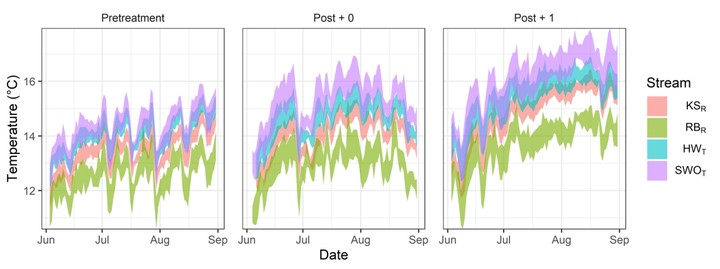Do southern Appalachian Mountain summer stream temperatures respond to removal of understory rhododendron thickets?
 Stream temperatures pre and post Rhododendron removal
Stream temperatures pre and post Rhododendron removalAbstract
Dense understory thickets of the native evergreen shrub Rhododendron maximum expanded initially following elimination of American chestnut by the chestnut blight, and later in response to loss of the eastern hemlock due to hemlock woolly adelgid invasion. Rhododendron thickets often blanket streams and their riparian zones, creating cool, low-light microclimates. To determine the effect of such understory thickets on summer stream temperatures, we removed riparian rhododendron understory on 300m reaches of two southern Appalachian Mountain headwater streams, while leaving two 300m reference reaches undisturbed. Overhead canopy was left intact in all four streams, but all streams were selected to have a significant component of dead or dying eastern hemlock in the overstory, creating time-varying canopy gaps throughout the reach. We continuously monitored temperatures upstream, within, and downstream of treatment and reference reaches. Temperatures were monitored in all four streams in the summer before treatments were imposed (2014), and for two summers following treatment (2015, 2016). Temperatures varied significantly across and within streams prior to treatment and across years for the reference streams. After rhododendron removal, increases in summer stream temperatures were observed at some locations within the treatment reaches, but these increases did not persist downstream and varied by watershed, sensor, and year. Significant increases in daily maxima in treatment reaches ranged from 0.9 to 2.6 C. The data indicate that overhead canopy provided enough shade to prevent rhododendron removal from increasing summer temperatures to levels deleterious to native cold-water fauna and that local temperature effects were not persistent.